Biology
In the middle of Northern hemisphere?s winter we use plants to help celebrate Christmas, but the practice is much older than Christmas. Decorating houses with evergreen boughs was related to the pagan tradition of the circle of the seasons, a guarantee that life would again return to the land.
It?s called irritant contact dermatitis (ICD) and can come from the wood or needles. Many people have trouble with the sawdust from cutting pine trees. I know it won?t kill me, but since I have few allergies and therefore am not used to being itchy, this bugs me.
One chemical in the pine needles, chrysin, could not only kill cancer cells on its own, but also prevented and reversed the molecular events in glioblastoma cells that had become insensitive to the cancer drugs used to treat gliobastoma. And lucky for us, Taiwan white pine needles are very low in ICA , so we can use it to treat cattle that are pregnant and have brain cancer?. and people too.
The berries of mistletoe are poisonous to humans, so I hope that the young men who had to pick the berry after a kiss didn?t just pop it in their mouth in an attempt to impress the girl or make her laugh. Both the leaves and the berries contain toxins that would require a call to Poison Control if ingested.
In a more philosophically complicated study, mistletoe extract was given to patients with advanced, terminal pancreatic cancer. Only patients who had refused further treatment were included in the study, to see if the mistletoe extract could improve their quality of life in the time they had remaining.
In keeping with the evil associated with ivy, all parts of the plant are toxic. Cats and horses are especially susceptible to the toxins ivy contains, including facarinol. Ingestion can lead to convulsions, breathing problems, paralysis and coma. At least in humans it takes a pretty large dose to bring on big trouble.
According to another recent study, a toxin from ivy leaves, hederagenin, induces colon cancer cells to kill themselves (apoptosis). I think the take home message here is that Christmas evergreens are pretty and can be meaningful, but don?t add them to the holiday meal unless instructed by a doctor.
Liu, B., Zhou, J., Li, Y., Zou, X., Wu, J., Gu, J., Yuan, J., Zhao, B., Feng, L., Jia, X., & Wang, R. (2014). Hederagenin from the leaves of ivy (Hedera helix L.) induces apoptosis in human LoVo colon cells through the mitochondrial pathway BMC Complementary and Alternative Medicine, 14 (1) DOI: 10.1186/1472-6882-14-412
Tröger W, Galun D, Reif M, Schumann A, Stankovi? N, & Mili?evi? M (2014). Quality of life of patients with advanced pancreatic cancer during treatment with mistletoe: a randomized controlled trial. Deutsches Arzteblatt international, 111 (29-30) PMID: 25142075
Tsui, K., Wang, J., Wu, L., & Chiu, C. (2012). Molecular Mechanism of Isocupressic Acid Supresses MA-10 Cell Steroidogenesis Evidence-Based Complementary and Alternative Medicine, 2012, 1-12 DOI: 10.1155/2012/190107
Earl, E., Altaf, M., Murikoli, R., Swift, S., & O'Toole, R. (2010). Native New Zealand plants with inhibitory activity towards Mycobacterium tuberculosis BMC Complementary and Alternative Medicine, 10 (1) DOI: 10.1186/1472-6882-10-25
- Intro To Cancer
Cancer starts as a genetic mutation in a few cells. The mutation can be due to radiation or some genetic problem. The cells then reproduce without stopping. The cancer cells find a place and then continue to reproduce until they create a tumor. The image...
- Weel Eight: Cell Biology Hiv And Aids
Western Approaches to AIDS I think that the Western approach to AIDS has bought a lot of people a lot of time. The drugs available to treat HIV and AIDS are costly, both financially and to the general health of the patient. But they do seem to be working...
- Cancer: Types, Causes, Diagnosis And Treatment
CANCER · Cancer is an abnormal and uncontrolled multiplication of cells resulting in the formation of tumor.· Normal cells show a contact inhibition (contact with the other cells inhibits their uncontrolled growth)....
- 2/20/14
...
- One Myrrh-aculous Christmas Gift
Biology concepts ? synergism, multidrug resistant cancers The Commiphora myrrha is the classic source for myrrh resin. It is a short tree that grows in low moisture and poor soil areas. Its branches are very thorny; some propose that the crown of thorns...
Biology
Christmas Greenery - Friend Or Foe?
Biology concepts ? toxin, botany, cancer chemotherapies, pregnancy, evergreen
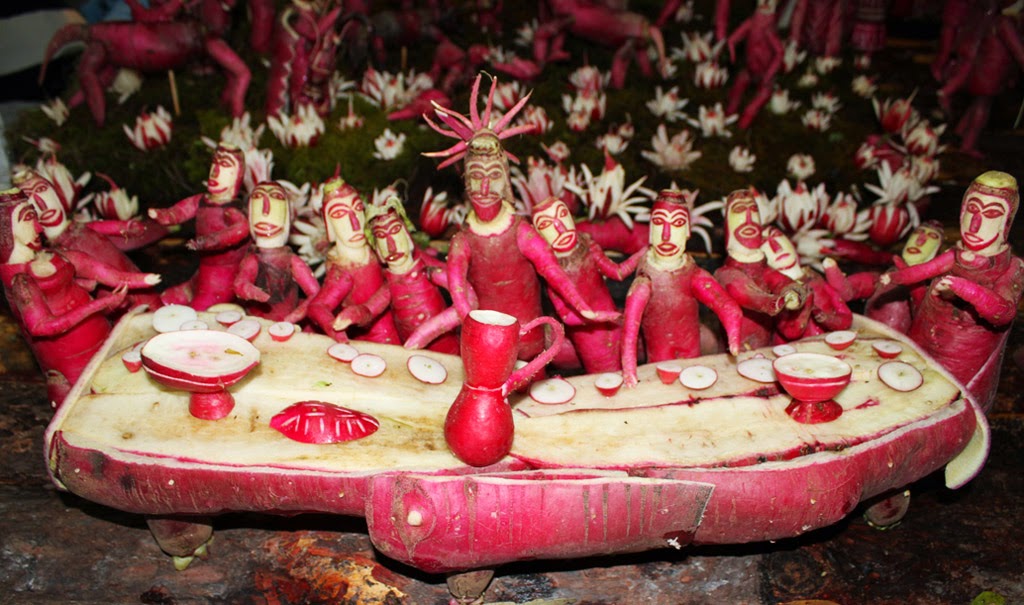 |
| Noche de Rábanos (Night of the Radishes) is celebrated in Oaxaca, Mexico on December 23. The townspeople carve radishes into shapes, characters or scenes and then they are judged. It began as a suggestion by a couple of monks to bring people in to the market to buy the produce that the farmers had raised, so it?s a Christmas plant tradition that really has little to do with Christmas. |
Different regions used different evergreens, based on their folklore and what was locally grown. The poinsettia (Euphorbia pulcherrima) wasn?t considered a winter flower at first. It is native to southern Mexico and Central America, where it carried no real significance in holiday traditions, but was used by the Aztecs for making red dye and for treating fevers (using just the sap).
The first US ambassador to Mexico, Joel Poinsett, brought them back to the states and distributed them to botanical gardens. In the 1950?s, the Tonight Show was one of the first shows to be broadcast in color, and growers offered them free poinsettia plants as set decoration near Christmas. This, with additional donations for magazine layouts and Bob Hope specials created a huge market for the flower, which is now the most popular potted plant in America.
No matter what plants your corner of the world has chosen to include in their winter holiday tradition, they bring joy and warmth and yes, a sense of returning spring. ?.. And many of them can kill you. To be fair, science is finding ways that they can save us as well. Let?s look at the major Christmas evergreens and how they can ruin or save your holiday.
Christmas trees ? Several species of pines are used in the United States and Europe as Christmas trees. While not lethal, my pet peeve is the itchy rash I get on my arms while putting the tree in its stand and decorating it.
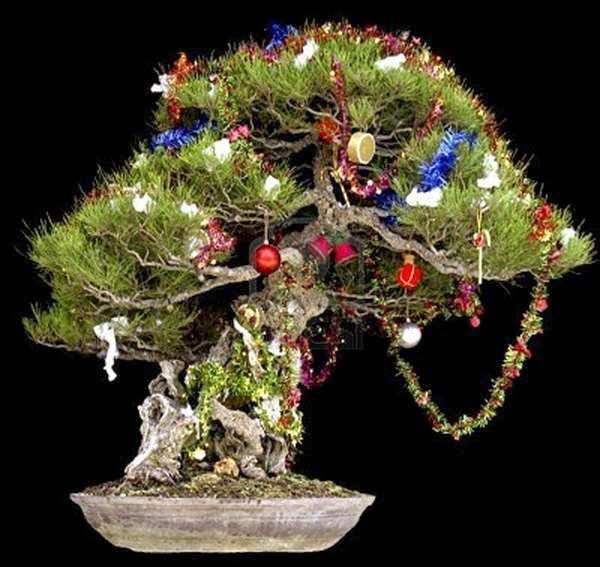 |
| Many types of firs, pines, and spruces are used for Christmas, but I think the bonsai Christmas has been severely underused. Think of the budget savings, not many presents will fit under that tree. And if it catches on fire, it might not even set off your smoke detector. |
Many people tout the health benefits of drinking tea made from pine needles, but this could get you into trouble. Many evergreen tree species (Ponderosa pine, Lodgepole pine, the cypresses, junipers) have high levels of a chemical called isocupressic acid (ICA).
ICA causes spontaneous abortions in cattle, and perhaps humans. A 2002 study showed that progesterone levels were affected by ICA. Progesterone is important for maintaining a pregnancy through the third trimester, ie. stopping premature labor. Progesterone relaxes the uterine muscles to prevent contractions; giving high risk women progesterone gel has been show to reduce premature delivery by 45%. You can see why ICA might be a problem.
A very recent study showed that ICA inhibits the transcription of two enzymes called StAR and P450scc. And a 2005 study links these two enzymes progesterone production. This is compelling evidence that eating pine needles that contain ICA suppresses the body?s work to prevent early labor.
On the other hand, pine needle tea might just save your life. A 2014 study showed that extracts from the Taiwan white pine (Pinus morrisonicola) needle can affect some cancer cells, specifically glioblastoma cells (cancer of the support cells of the brain).
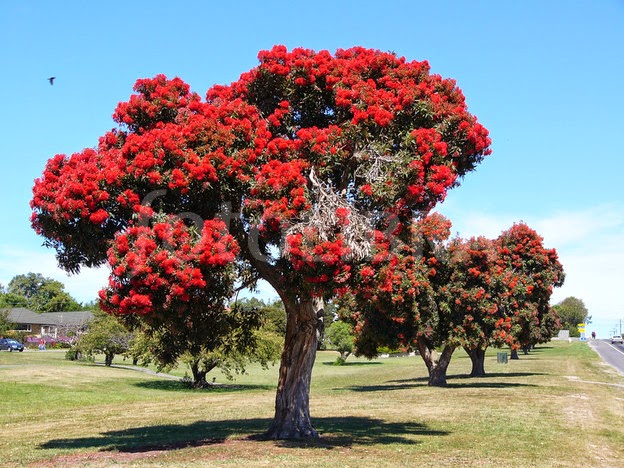 |
| Not all Christmas trees are evergreens. The New Zealand Christmas tree (Metrosideros excelsa, or pohutukawa) turns red around Christmas. A 2010 study indicated that extracts from this tree were lethal to tuberculosis organisms as well as Staph. aureus?.. you know, that bacteria that is becoming resistant to so many antibiotics. |
Speaking of cancer drugs, a different kind of evergreen tree is the source of one of the most powerful cancer chemotherapeutics we have. In many parts of Britain and Europe, yew trees were used as Christmas trees instead of pines or firs. Taxol itself is found in greatest quantity in bark of the slow growing Pacific Yew.
As you have probably guessed, some people like to make tea from the bark of the Pacific Yew, so it care needs to be taken here as well. Remember that cancer drugs kill cells that are reproducing. In the case of taxol, the chemical binds to parts of the cell that help line up and pull apart the chromosomes during mitosis (called microtubules).
Since normal cells use microtubules in exactly the same way as cancer cells do for cell division, taxol inhibits their function as well. This is why people lose their hair during many cancer treatments. Cancer drug therapy is balanced on a knife edge; hopefully it kills the fast dividing cancer cells just a little bit better and faster than it kills the cells that we need, like stomach lining cells, bone marrow cells, and hair follicles.
Mistletoe ? prior to the advent of the Christmas tradition in Britain, kissing bunches were popular. An evergreen would be hung in a circular hoop and couple would kiss beneath it. In some traditions, the white berries of the mistletoe (Viscum album) also were used. Each time a kiss was taken, a berry had to be pulled; when the berries were gone, the kissing was over.
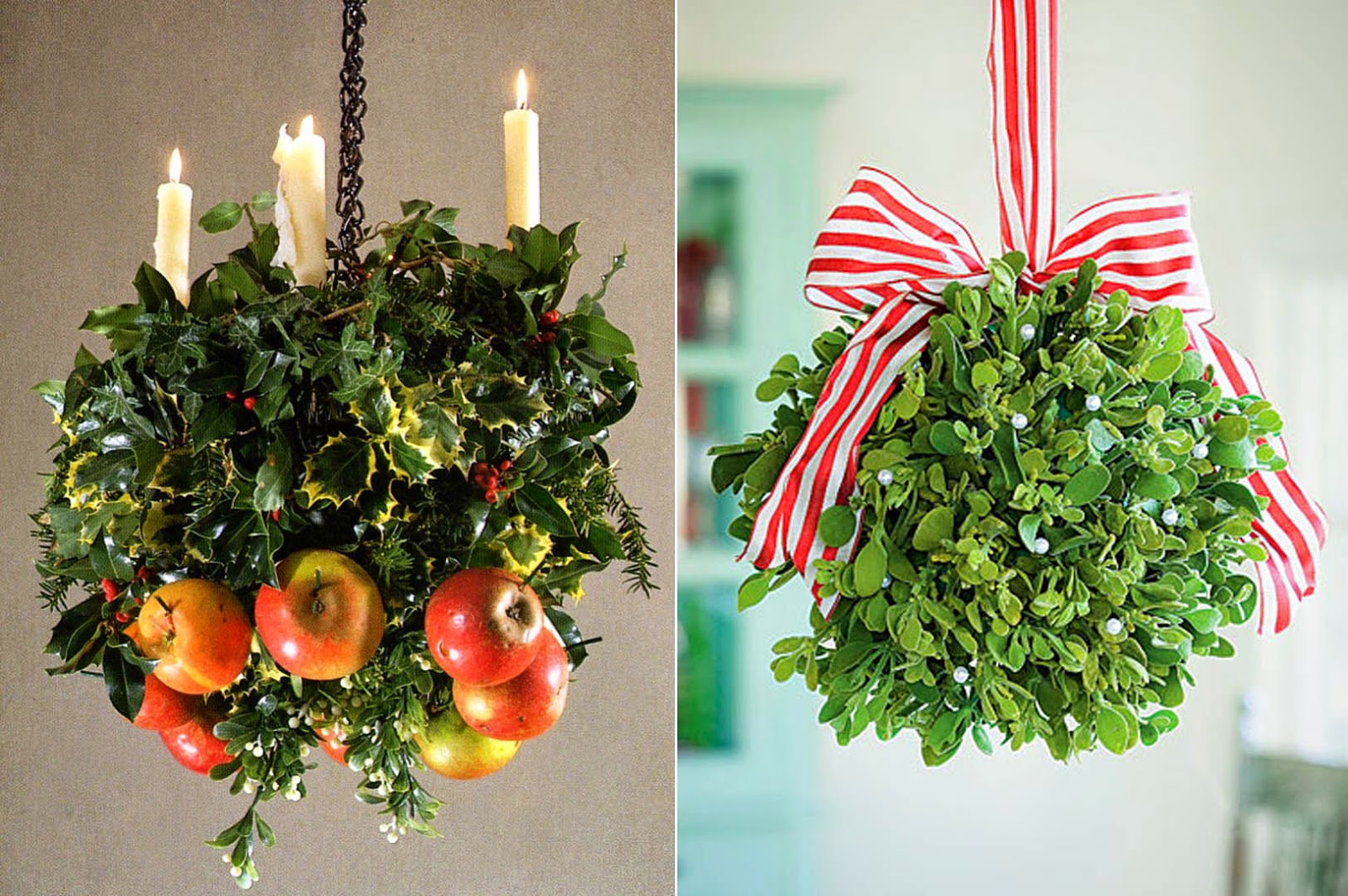 |
| On the left is the older kissing hoop, or kissing bough. The purpose of the apples eludes me, but they may be there to keep the hot wax from dripping on your head. The right side is our more modern mistletoe bough. It still has the white berries, but we don?t pick them off with each kiss anymore. |
Different species have different cocktails of toxins, but most, including phoratoxin and tyramine, will bring you (before they kill you) nausea, vomiting, blurred vision, and dangerously low blood pressure. Some companies tout European mistletoe extract as a natural antihypertensive treatment, but safe dosages have not been worked out, so I would caution against it as an herbal medicine not taken under a doctor?s supervision.
ON THE OTHER HAND, some extracts from some species of mistletoe might save your life. A chemical called viscothionin from a Korean species of mistletoe has been shown in a 2014 series of experiments to improve liver function in people that have fatty buildups in their liver tissue. Another 2014 study showed similar benefits to the liver and other tissues in rats that had low levels of estrogen, implying that it could be of benefit to post-menopausal women.
| Pancreatic cancer is staged from 1 to 4, with 1 being the least aggressive or least progressed. Notice that the survival timess are in MONTHS, not years. No wonder we need to find additional drugs for this cancer and why people are looking for drugs to make people?s live easier while they suffer with this cancer. |
It did, as witnessed by increased body weight, increased appetite, less pain, better sleep, and less fatigue during the day. Great you say, but it also prolonged their life. Again you say great?.. but I wonder if is this what all the patients wanted? Improved quality of life is amazing, but if they live longer, it just means living a little longer with a horribly painful cancer. A study of the ethics of this treatment should be warranted as well.
Ivy ? Hedera helix is scientific name for English ivy, used for centuries in Christmas decorations and symbols. One of the most popular Christmas carols remains, The Holy and the Ivy, but we will focus on just the ivy here.
As an evergreen, ivy was used as a symbol of everlasting life, but there was a time when Christians in England outlawed the use of ivy as a Christmas decoration. Some thought that since it grows in the shade, it could represent the sin that takes place outside of the light of day; secrecy and debauchery must have been on their minds.
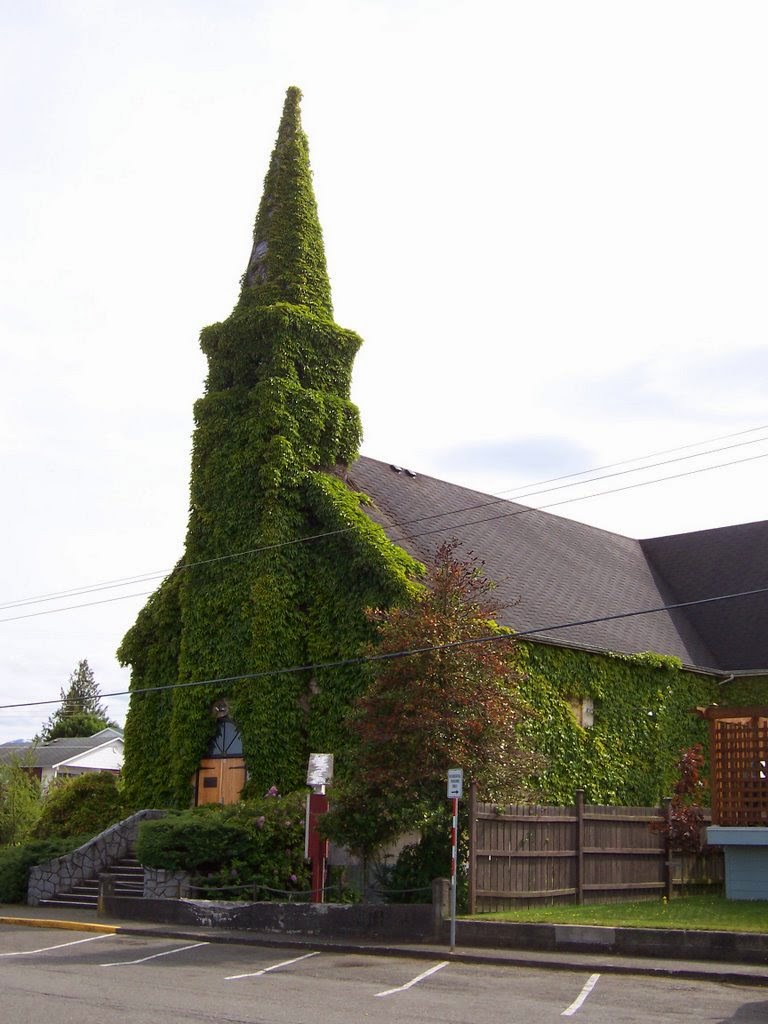 |
| English churches used to decorate the outside with ivy for Christmas, but only the outside. And of, course this during the period when they believe that ivy was the houseplant of the devil. I?m not sure why they would decorate with ivy, most of them are covered with it anyway. |
However, many people develop a contact dermatitis reaction to ivy. Weeping blisters are common and severe itching accompany even the slightest contact. Heaven forbid the kind of itching that might accompany the eating of ivy! A 2010 review concluded that ivy should be one of the standard botanical allergens to be tested for.
ON THE OTHER HAND, ivy extracts might save your life. The same toxin that makes you sick, falcarinol, inhibits breast cancer cells from becoming resistant to cancer drugs (2014 study). Falcarinol stops the action of proteins in the cancer cell that work to pump cancer drugs back out. Called efflux pumps, cancer cells with increased pump activity keep pumping the cancer drugs out of the cell. Ivy extract stops the efflux pump from being produced so the cancer drug can do its job.
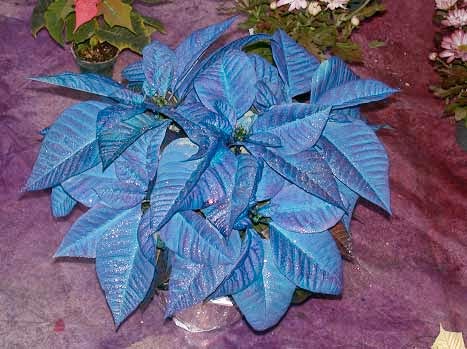 |
| The poinsettia has undergone many hybridizations over the years and has been selectively bred to keep its colored bracts (leaves) for much longer. But the purpose of the blue poinsettia escapes me. Is it supposed to look cold? My wife says it doesn?t have to have a purpose, it?s just pretty. |
And as for poinsettia, they have a bad reputation for being poisonous, but a child would have to eat about 500 leaves for them to be in big trouble. And they taste so bad, that no kid would eat more than one. It?s strange how some have the reputation and other that are more dangerous are not thought of as toxic.
Next week, myrrh was one of the original Christmas gifts. It had many functions in ancient times, but now we know WHY it's such a great gift.
Since most of this post is about how certain plants can be poisonous, I have decided not to include links for more information on how these things can kill you. If you must know, you?ll have to look them up yourself.
- Intro To Cancer
Cancer starts as a genetic mutation in a few cells. The mutation can be due to radiation or some genetic problem. The cells then reproduce without stopping. The cancer cells find a place and then continue to reproduce until they create a tumor. The image...
- Weel Eight: Cell Biology Hiv And Aids
Western Approaches to AIDS I think that the Western approach to AIDS has bought a lot of people a lot of time. The drugs available to treat HIV and AIDS are costly, both financially and to the general health of the patient. But they do seem to be working...
- Cancer: Types, Causes, Diagnosis And Treatment
CANCER · Cancer is an abnormal and uncontrolled multiplication of cells resulting in the formation of tumor.· Normal cells show a contact inhibition (contact with the other cells inhibits their uncontrolled growth)....
- 2/20/14
...
- One Myrrh-aculous Christmas Gift
Biology concepts ? synergism, multidrug resistant cancers The Commiphora myrrha is the classic source for myrrh resin. It is a short tree that grows in low moisture and poor soil areas. Its branches are very thorny; some propose that the crown of thorns...
